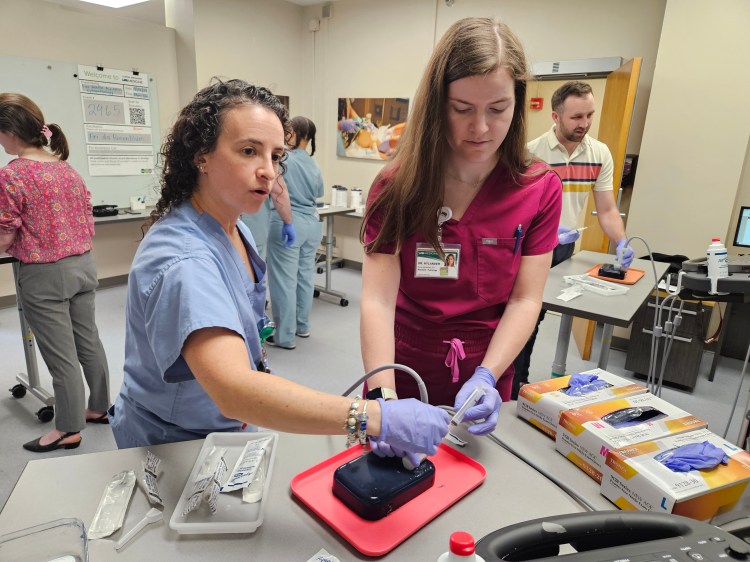New Fine Needle Aspiration sim benefits pathology residents, fellows

One of UAB Clinical Simulation’s newest procedural sims gets right to the point.
Fine needle aspiration is a medical procedure in which a very thin needle is inserted into a mass or lesion (with or without the use of ultrasound imaging) to sample and acquire cells for microscopic evaluation.
And although the needle is small, the procedure itself is a pretty a big deal.
“This procedure is incredibly important because it is minimally invasive, can be done without any anesthesia and in any medical setting, such as a clinic or bedside,” said Frida Rosenblum, M.D., associate professor and director of the Cytopathology Fellowship in UAB Heersink School of Medicine’s Department of Pathology.
In many cases, Rosenblum explained, fine needle aspiration (FNA) can provide answers to diagnostic questions with rapid turn-around.
“Furthermore, the needle used for FNAs is, in most cases, of a thinner caliber than the one used for blood draws,” she said. “The advantages of this procedure being performed by pathologists is that it is not just about ‘getting cells,’ but about getting the most cells, the right cells and handling the cells appropriately. This requires additional training and proper technique in making smears, triaging a specimen for further testing and even giving a rapid on-site assessment.”
As Cytopathology Fellowship director, Rosenblum wanted to provide her fellows with as much training as possible before treating patients. So, she contacted UAB Clinical Simulation.
“The simulation team was able to provide me with everything I needed—a physical space with enough ultrasound machines for four residents at a time, as well as gelatin molds with targets inside them to simulate solid or cystic nodules,” she said. “We kept the molds simple, as we wanted to teach basic techniques to the residents, allowing the fellows to also practice and teach the residents.”
There’s a common misconception surrounding FNA, Rosenblum explained, in that many medical students, residents and fellows think performing it “is easy and almost like shooting darts, particularly when they see proficient physicians doing them under ultrasound guidance.”
In keeping with UAB Clinical Simulation’s “Sim First” motto, the FNA simulation is a bullseye.
“This training shows them that like anything, it is a skill that needs to be properly taught and practiced before being performed on actual patients,” Rosenblum said. “This training puts their hand and eye coordination to the test and shows them different techniques they can use to sample a lesion via FNA.”
Rosenblum noted that learner feedback has been overwhelmingly positive.
“They absolutely loved and appreciated the opportunity, as this was something that had always been missing from their training and a deficiency of our residency program,” she said.
To learn how simulation can benefit your department or team, email simulation@uabmc.edu.
UAB Medicine’s Clinical Simulation program offers opportunities for individuals and teams across UAB Medicine and beyond to practice before they deliver care. We encourage all who provide and support patient care to “Sim First.” Together, we can put our patients’ safety first.




0 Comments